Winter fun a 'long-standing tradition' on frozen rivers in Winnipeg
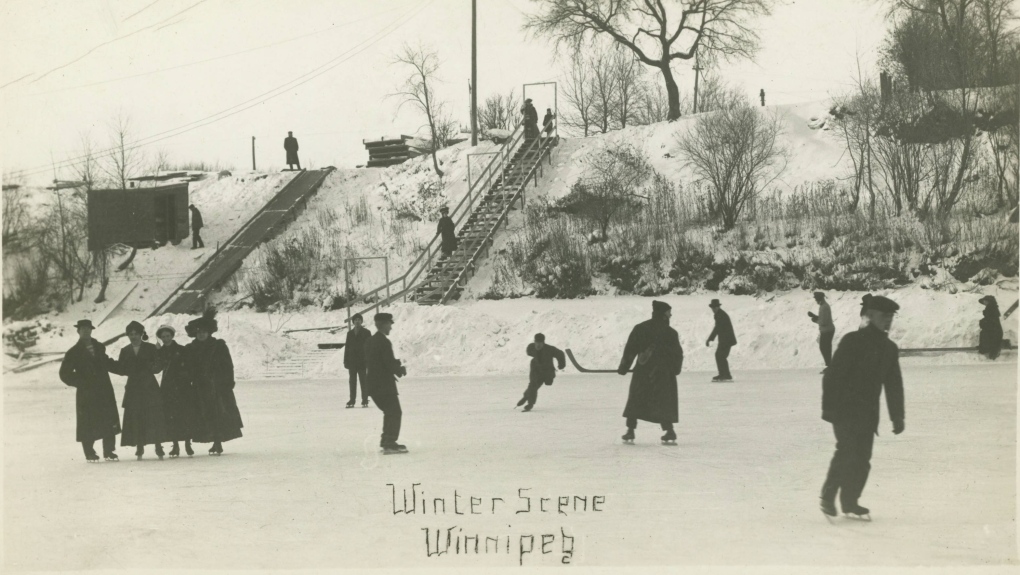 Several people skate on a rink cleared on a frozen river in Winnipeg. The photo is believed to have been taken between 1900 and 1920. (Source: Martin Berman Postcard Collection/ Winnipeg Past Forward)
Several people skate on a rink cleared on a frozen river in Winnipeg. The photo is believed to have been taken between 1900 and 1920. (Source: Martin Berman Postcard Collection/ Winnipeg Past Forward)
Countless Winnipeggers have laced up their skates and hit the river trail at The Forks – it is a long-standing tradition in a city that has learned to thrive on winter activities all centred on its frozen rivers.
"During the fur trade and during the Red River settlement days, winter was really a time of community and a time of sort of get together," said Winnipeg historian Murray Peterson.
"That just moved forward as technology improved and as the population increased, and so you got large, which looked like incredibly fun, wooden slides for toboggan slides. There was lots of river cleared for skating and snowshoeing and all sorts of activities along the river."
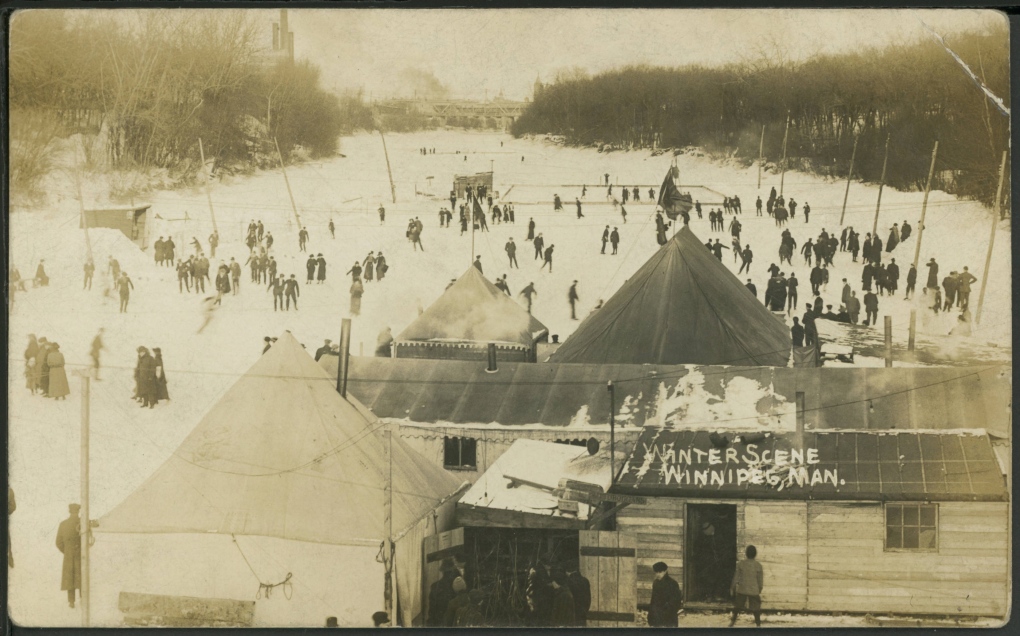 A look down the frozen Assiniboine River as people take part in all sorts of winter activities. The photo is believed to have been taken between 1900 and 1920. (Source: Martin Berman Postcard Collection/ Winnipeg Past Forward)
A look down the frozen Assiniboine River as people take part in all sorts of winter activities. The photo is believed to have been taken between 1900 and 1920. (Source: Martin Berman Postcard Collection/ Winnipeg Past Forward)
Historic photos give a glimpse at what winter was like at the turn of the century in Winnipeg, from tobogganing runs that operated on the river as early as the 1890s, to a ski jumping hill on the bank of the Red River in River Park.
"I mean one of the things that we always laugh about is how high those toboggan runs are, and that, probably wouldn't be allowed by bylaw now to build something that massive," Peterson said.
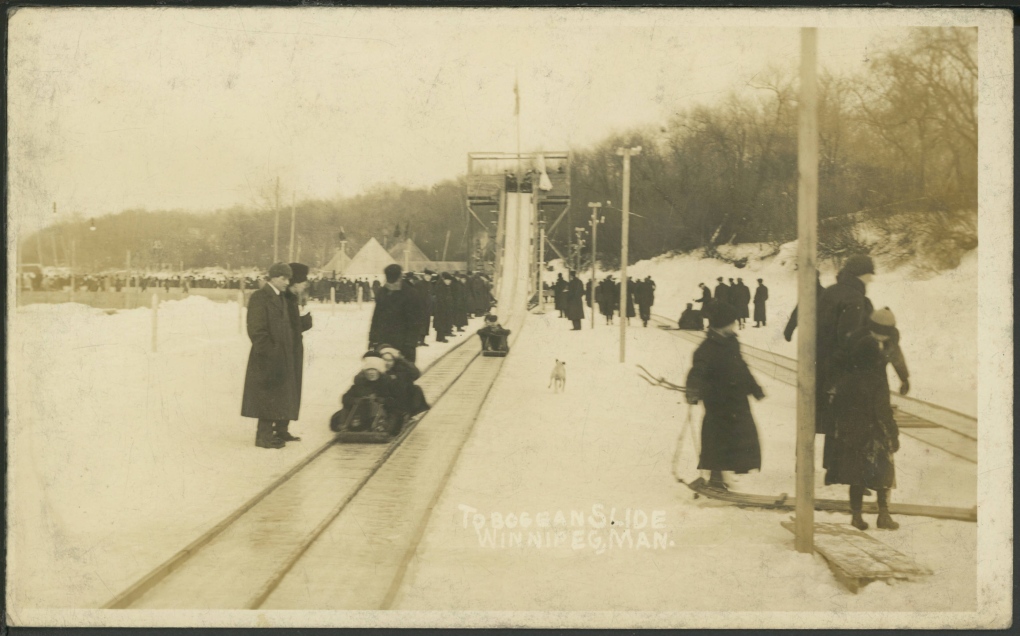 Winnipeggers have fun on two toboggan slides along the Assiniboine River near the Forks in Winnipeg. The photo is believed to have been taken between 1900 and 1920. (Source: Martin Berman Postcard Collection/ Winnipeg Past Forward)
Winnipeggers have fun on two toboggan slides along the Assiniboine River near the Forks in Winnipeg. The photo is believed to have been taken between 1900 and 1920. (Source: Martin Berman Postcard Collection/ Winnipeg Past Forward)
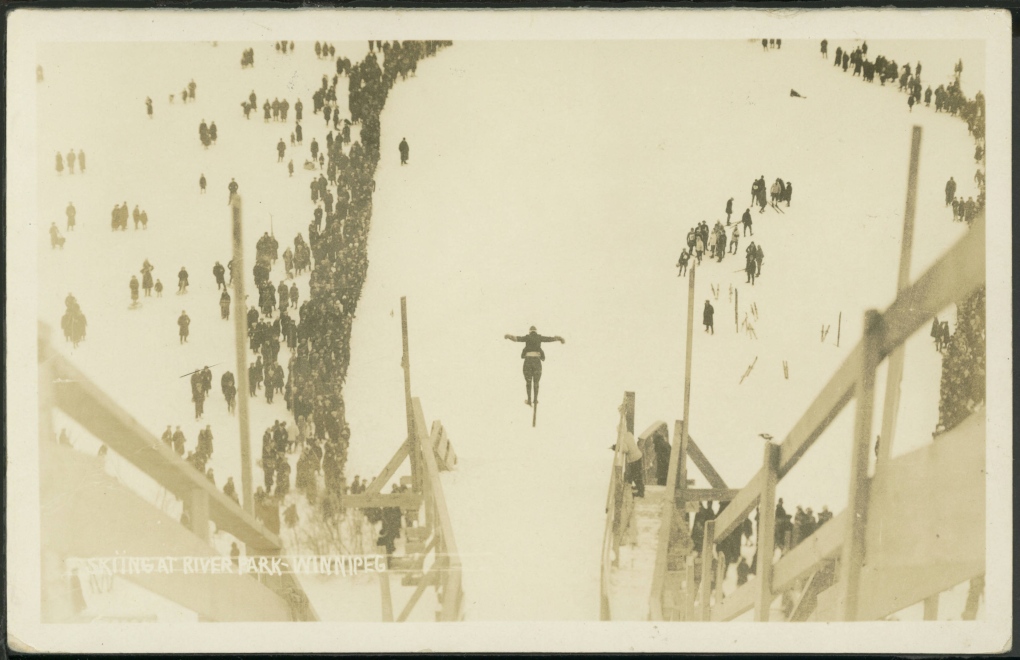 A skier launches off a ski jumping hill on the bank of the Red River in River Park in Winnipeg some time between 1920 and 1942. (Source: Martin Berman Postcard Collection/ Winnipeg Past Forward)
A skier launches off a ski jumping hill on the bank of the Red River in River Park in Winnipeg some time between 1920 and 1942. (Source: Martin Berman Postcard Collection/ Winnipeg Past Forward)
"It was a very busy time on the river for sure. And then they would have winter carnivals that spilled out from the banks onto the river and it was very well used," Peterson said.
Among the photos of those winter carnivals – one man wearing ice skates tries his hand at barrel jumping on the frozen river during the 1924 Winnipeg Winter Carnival.
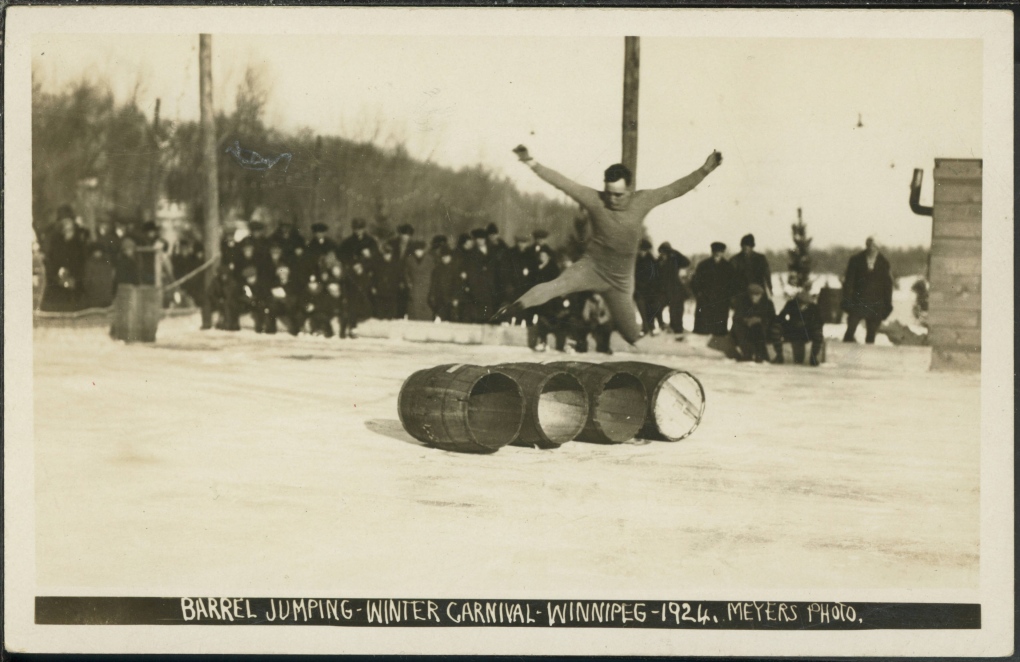 One man wearing ice skates tries his hand at barrel jumping on the frozen river during the 1924 Winnipeg Winter Carnival. (Source: Martin Berman Postcard Collection/ Winnipeg Past Forward)
One man wearing ice skates tries his hand at barrel jumping on the frozen river during the 1924 Winnipeg Winter Carnival. (Source: Martin Berman Postcard Collection/ Winnipeg Past Forward)
After nearly a century, some of those winter activities continue on Winnipeg's frozen rivers.
"We've obviously not been the first to think about how great our winters are and how people have been enjoying them for a very long time," said Clare MacKay, the executive director of The Forks Foundation, and vice president of strategic initiatives.
"We are really thrilled to be able to see that we're carrying on a long-standing tradition of Winnipeggers getting outside and enjoying their winters."
How those winter activities have evolved over the years has been really interesting for MacKay.
She said while there have always been activities on the frozen rivers – Winnipeg really gained international attention for its winter recreation when in 2008 The Forks set a Guinness World Record for the longest naturally frozen skating surface (about 8.5 kilometres) along the Assiniboine River.
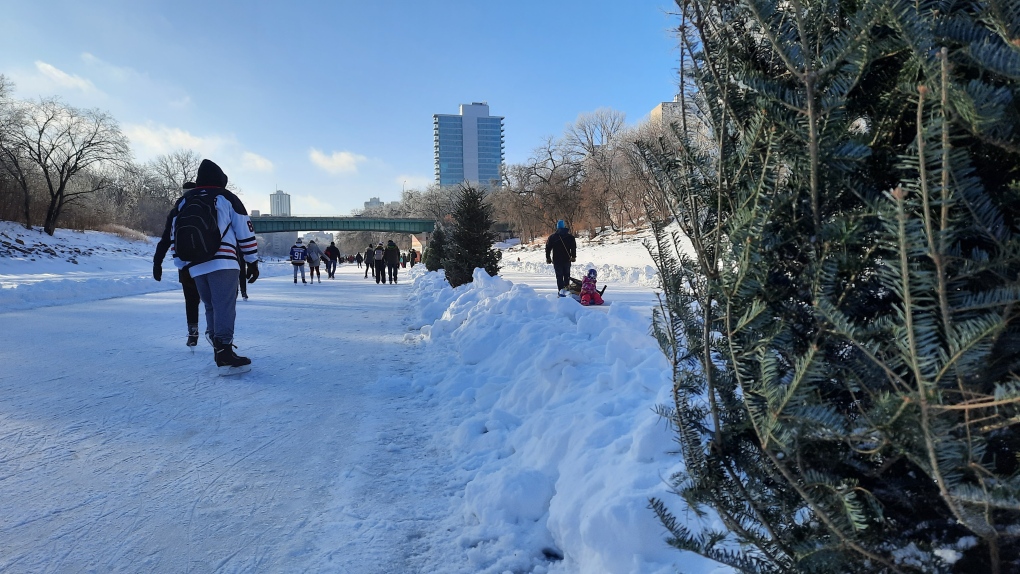 People skating on Centennial River Trail January 9 (Dan Timmerman/CTV News)
People skating on Centennial River Trail January 9 (Dan Timmerman/CTV News)
"That kind of really changed the game for us. It gave us some international recognition," she said.
This year, the Nestaweya River Trail stretches just over six kilometres.
READ MORE: Nestaweya River Trail at the Forks opens
While Winnipeg no longer boasts that world record – a title now held by Lake Windermere Whiteway's skating trail in B.C. which measured 29.98 kilometres long in 2014 – the winter activities at The Forks have continued to expand.
Other events, including The Forks' international art and architecture warming huts competition, have caught the eyes of countries around the world including China, Brazil, Mexico, Finland, and the Czech Republic.
This year, MacKay said The Forks has also added a cross-country ski path. However, it is not just The Forks taking advantage of the frozen rivers.
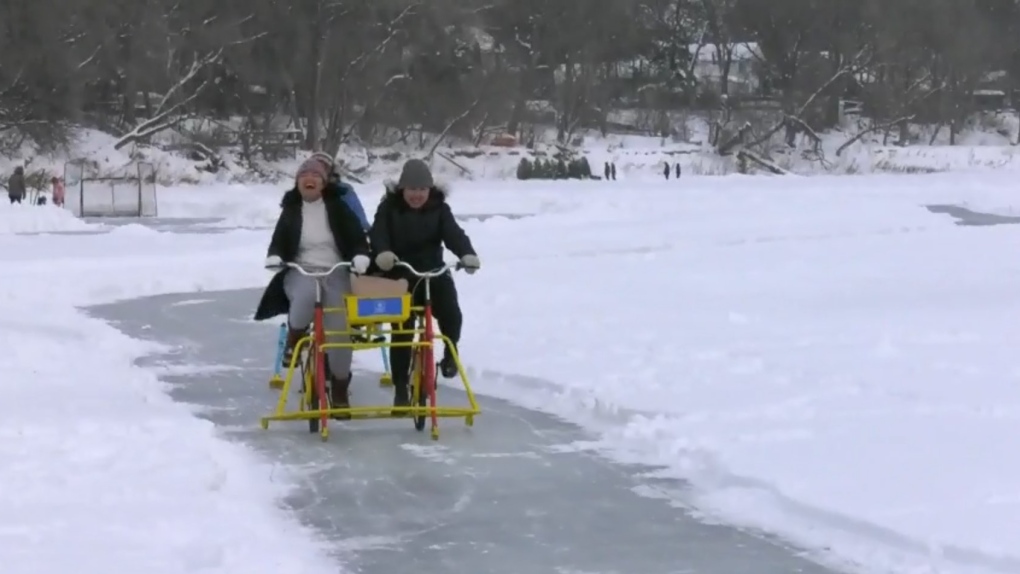
All sorts of activities have hit the ice in recent months. Take for example ice bikes – a new winter activity Winnipeggers can rent to cycle along the Assiniboine River.
Or the team of dragon boat paddlers who showed Manitoba it is possible to paddle on ice.
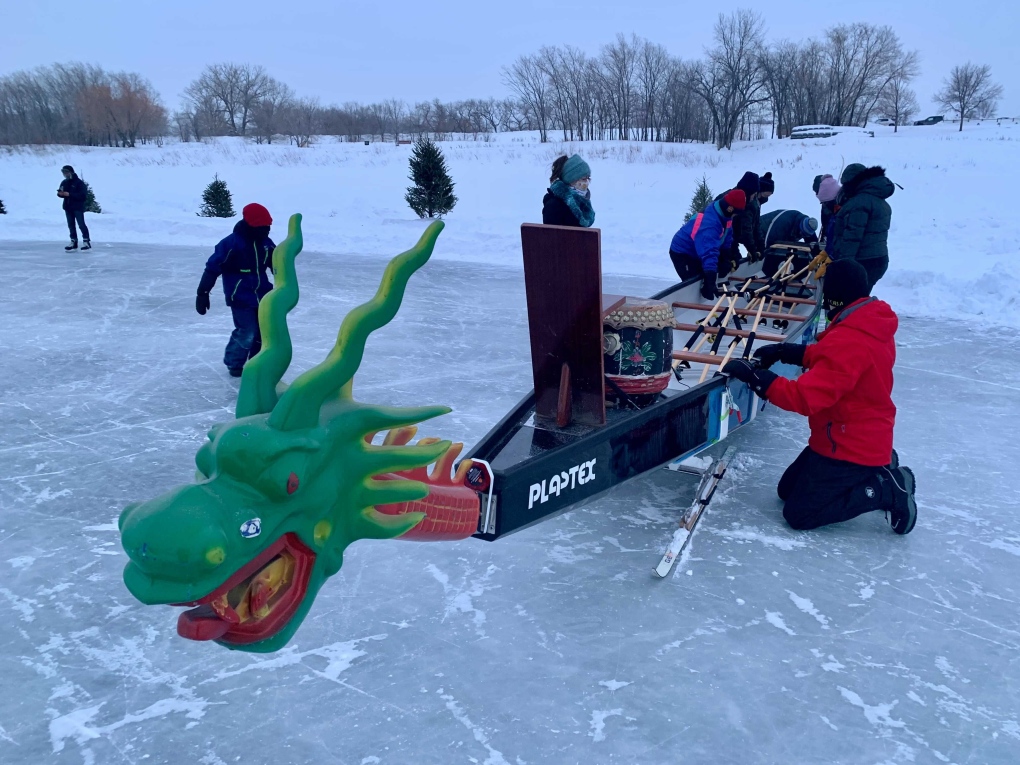
Art too has been added to the river – one artist Kal Barteskiis showed off her love of winter, ice and the river trail with a display of frozen flowers.
Another group of artists and architects took to the ice to reclaim an age-old tradition of harvesting ice blocks from the river to be used for ice sculptures throughout Winnipeg's Downtown.
 A group with Sputnik Architecture in Winnipeg harvests ice from the Red River on January 20,2022. (Source: Zachary Kitchen/ CTV News Winnipeg)
A group with Sputnik Architecture in Winnipeg harvests ice from the Red River on January 20,2022. (Source: Zachary Kitchen/ CTV News Winnipeg)
"We've sort of always apologized for (our winters) before," said MacKay. "Now with things like warming huts with the international and national attention that we gain from this the way a river trail, I think people are starting to take pride more in it and in our winters."
As for Peterson, it is not just the activities that drive Winnipeggers to bundle up and get outside despite the winter cold.
"You got a real community down there," he said. "There's a lot of stuff to do down there, just like it was back in the 1900s."
CTVNews.ca Top Stories

BREAKING Donald Trump picks former U.S. congressman Pete Hoekstra as ambassador to Canada
U.S. president-elect Donald Trump has nominated former diplomat and U.S. congressman Pete Hoekstra to be the American ambassador to Canada.
Genetic evidence backs up COVID-19 origin theory that pandemic started in seafood market
A group of researchers say they have more evidence to suggest the COVID-19 pandemic started in a Chinese seafood market where it spread from infected animals to humans. The evidence is laid out in a recent study published in Cell, a scientific journal, nearly five years after the first known COVID-19 outbreak.
This is how much money you need to make to buy a house in Canada's largest cities
The average salary needed to buy a home keeps inching down in cities across Canada, according to the latest data.
'My two daughters were sleeping': London Ont. family in shock after their home riddled with gunfire
A London father and son they’re shocked and confused after their home was riddled with bullets while young children were sleeping inside.
Smuggler arrested with 300 tarantulas strapped to his body
Police in Peru have arrested a man caught trying to leave the country with 320 tarantulas, 110 centipedes and nine bullet ants strapped to his body.
Boissonnault out of cabinet to 'focus on clearing the allegations,' Trudeau announces
Prime Minister Justin Trudeau has announced embattled minister Randy Boissonnault is out of cabinet.
Baby dies after being reported missing in midtown Toronto: police
A four-month-old baby is dead after what Toronto police are calling a “suspicious incident” at a Toronto Community Housing building in the city’s midtown area on Wednesday afternoon.
Sask. woman who refused to provide breath sample did not break the law, court finds
A Saskatchewan woman who refused to provide a breath sample after being stopped by police in Regina did not break the law – as the officer's request was deemed not lawful given the circumstances.
Parole board reverses decision and will allow families of Paul Bernardo's victims to attend upcoming parole hearing in person
The families of the victims of Paul Bernardo will be allowed to attend the serial killer’s upcoming parole hearing in person, the Parole Board of Canada (PBC) says.


































